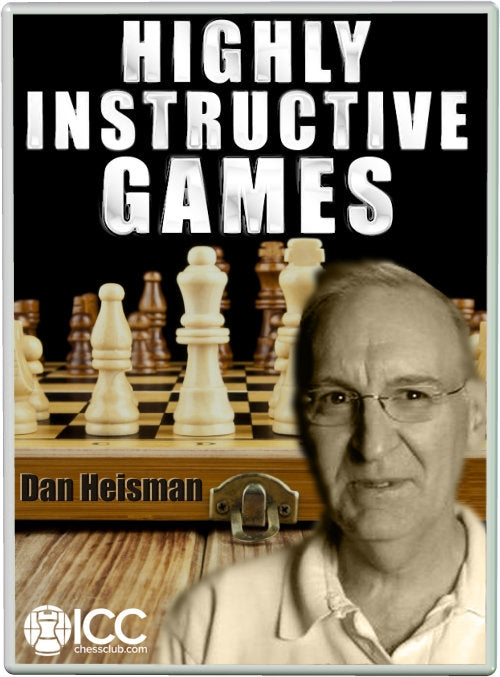ICC chessclub.com
HIGHLY INSTRUCTIVE GAMES - by Coach Dan Heisman
HIGHLY INSTRUCTIVE GAMES - by Coach Dan Heisman
Couldn't load pickup availability
HIGHLY INSTRUCTIVE GAMES by Coach Dan Heisman
How many times have you heard an expert, or even a GM, tell you that to take your chess to the next level you need to study classic games? And how many times have you tried to go over famous games, failing to understand all the subtleties that the great masters used to get an advantage? It sounds almost like a rhetorical question, doesn't it?
What if you had a renowned coach explain you, step by step, from opening to endgame, what really happened? It would be like wanting to improve your writing and have Stephen King be your guide through the many levels of the craft: outline to the story, define the characters, making the plot intriguing, and use correctly the figures of speech.
From Steinitz to Alekhine, Lasker, Reti, Zukertort, Spassky, Fischer, Karpov, Kasparov, Anand, Gelfand, Karjakin, Carlsen, and many others; from the great Masters of the past to the latest generation of champions, coach Heisman in this fantastic course uses a selection of amazing games to take you into the core of the game.
By watching these videos, you'll find yourself be more confident and your understanding of the game will skyrocket, getting your rating up quickly!
Chapter 1: Lasker-Vidmar 1909
St. Petersburg RUE, rd 11, Mar-01
Spanish Game: Steinitz Defense (C62)
World Champion Lasker plays the White side of the Ruy Lopez and the players castle opposite sides. Due to Black's fianchetto and despite the opening, the middlegame resembles a Yugoslav Dragon attack. Despite the date the game was played, Lasker plays the kingside attack in a modern style. Vidmar misses the 'anti-positional' defense ..Bg7xBh6 and thus allows Lasker develop a winning position, where he carries off the attack masterfully.
Chapter 2: Reti-Becker 1923
Vienna AUT, rd 6, Nov-26
English Opening: Symmetrical Variation. Full Symmetry Line (A38)
Reti and Becker turn a 'Reti Opening' (1.Nf3) into a Symmetric English. Reti delays castling and, when Becker plays passively, launches a 'Dragon-type' kingside attack. First Reti soundly sacrifices a pawn but he makes several inaccurate moves, allowing Becker chances to not only equalize, but even obtain a superior position. Reti ends up sacrificing multiple pawns, but wins a piece when Becker miscalculates in complications. At one point Becker has six pawns for a piece but Reti has open lines and a winning position. Reti then misplays the attack, allowing Becker possible equality and more, when Becker makes a disastrous king move, finally succumbing to the kingside attack.
Chapter 3: Grigoriev-Alekhine 1915
Moscow (1915), Moscow RUE
French Defense: McCutcheon. Grigoriev Variation (C12)
In a complicated opening, Alekhine equalizes but then blunders into a losing combination. Grigoriev misses the win and instead blunders himself into a devastating attack which quickly yields Alekhine the win. However, years later Alekhine claims a '5-queen' game where he was White and the game deviated from the actual Grigoriev game into a fantastic variation. History claims that Alekhine fabricated the 5-queen game from his actual game with Grigoriev. To add some spice, I have included some modern Stockfish notes. Thanks to Tim Krabbe's book and website 'Chess Curiosities' for providing historical perspective.
Chapter 4: Spassky-Fischer Game 3, 1972
Reykjavik ISL, rd 3, Jul-16
Benoni Defense: Knight's Tour Variation (A61)
Fischer, down 0-2, causes a sensation with his 'anti-positional' offer ..Nf6-Nh5. Spassky correctly accepts the challenge but misplays slightly and grants Fischer first equality and then the better position. As happens so often, the GM under pressure eventually makes some second-best moves and drifts from a difficult position to lost. Once Fischer gets the winning position, his technique, not surprisingly, is excellent, and he brings home the entire point. That makes this game not only instructive, but historically important as Fischer amazingly turned the 2-0 deficit into a 6.5-3.5 lead after 10 games en route to his title.
Chapter 5: Seidman-Santasiere 1939
New York (1939)
Sicilian Defense: Nimzowitsch. Exchange Variation (B29)
Stockfish finds a cute 'computer win' that Seidman misses in the opening but he gets a large advantage anyway. Black's pieces get cut off from the kingside and Seidman launches a justified attack there. Prompted, Seidman sacrifices multiple pieces for a murderous attack. Santasiere tries to give back some of the material, but Seidman's attack is just too deadly and Santasiere's king gets caught in the middle and the crossfire is too much. First seen in Chernev's book The Bright Side of Chess.
Chapter 6: Alekhine-Rubinstein 1921
The Hague (1921), The Hague NED, rd 9, Nov-04
Queen Pawn Game: Zukertort Variation (D02)
Rubinstein makes some unusual opening moves and Alekhine replies with even more unusual ones to gain a big advantage. Alekhine wisely points out that playing the kind of moves he made is not normal and usually incorrect. Both sides then play a series of inaccuracies where Rubinstein misses the best defenses and Alekhine finds the wrong plans. But eventually Rubinstein falters under the pressure and Alekhine obtains a winning endgame, which he wins rather easily.
Chapter 7: Zukertort-Steinitz 1886
New York, First World Championship
Queen Gablit Declined (D53)
Zukertort makes an instructive error in the opening and gives Steinitz the center. Then he delays castling too long and Steinitz creates a central bind. Steinitz then finds a killing pseudo-sacrifice and obtains an overwhelming position. He can win back the material as he pleases but he decides to just exploit his two connected passed central pawns, and Zukertort quickly succumbs.
Chapter 8: Karjakin-Anand 2006
Corus (2006), Wijk aan Zee NED, rd 1, Jan-14
Sicilian Defense: Najdorf Variation. English Attack (B90)
In a model of pre-game computer preparation, Anand plays a major sharp line in the Sicilian Najdorf English Attack. At home, he finds a brilliant improvement over an Informant suggestion with 24..Nc7! But even that does not end the game, as several sharp (also likely prepared) moves follow leaving him with a completely won position. After a few more attempts to defend, Karjakin goes down to an Anand mating attack.
Chapter 9: Bernstein-Mieses 1904
Coburg (Meisterturnier) (1904), Coburg GER, rd 13, Aug-01
Sicilian Defense: Four Knights. Exchange Variation (B45)
Meises plays the interesting Four Knights Variation of the Sicilian but he plays a line now considered dubious. Bernstein obtains first the bishop pair but then bind on the dark squares (hence Chernev's title 'That Old Black Magic'). White instructively invades and blockades the dark squares, forcing Black into first passivity, and then slowly losing material. Bernstein finally allows a trade into a bishop of opposite color endgame, but one that is easily won.
Chapter 10: Carlsen-Gelfand 2013
World Championship Candidates (2013), London ENG, rd 10, Mar-27
Sicilian Defense: Nezhmetdinov-Rossolimo Attack (B30)
Gelfand equalizes in the opening but Carlsen, as usual, keeps applying subtle pressure. Eventually Carlsen builds up winning chances but Gelfand hangs in for a long time. Through a series of tactical tricks Carlsen gets into a better endgame with heavy pieces still on the board. Gelfand sacrifices a pawn for play but in some complications does not find the best defense. Carlsen eventually sacrifices a piece to get connected passed pawns but Gelfand captures that piece with the wrong piece and Carlsen's threats to promote quickly force victory.
Chapter 11: Kasparov-Shirov 1994
Credit Suisse Masters (1994), Horgen SUI, rd 9, Sep-13
Sicilian Defense: Lasker-Pelikan. Sveshnikov Variation Chelyabinsk Variation (B33)
Kasparov makes a stunning, instructive, and memorable exchange sacrifice on move 17. He gains a slight advantage but both sides play some slight inaccuracies, eventually leaving Kasparov with some trademark attacking chances. Then the tactics really begin to fly as Kasparov does his stuff and finishes off Shirov in a superb manner (once again!).
Chapter 12: Karpov-Kasparov 1990
Kasparov - Karpov World Championship Match (1990), New York, NY USA, rd 3, Oct-15
King's Indian Defense: Orthodox Variation. Gligoric-Taimanov System (E92)
Kasparov plays a risky opening line and then sacrifices the exchange for a pawn and the bishop pair. Karpov obtains a lead in development and Kasparov further sacrifices his queen for a rook and knight. However, Karpov misses a clever way to ensure the advantage. Complicated play ensures and eventually Karpov sacrifices back his queen, also for a rook and knight. An imbalanced endgame results with roughly even material and both sides play at a high level, finishing in a well-deserved draw.
Chapter 13: Heisman-Pariseau 1999
I play an English which NM Pariseau defends as a Reverse Benoni: White gets the kingside pawn majority and Black the queenside. Using a deep positional combination, I active my majority. Then, with a series of (uncharacteristically) accurate moves, I take advantage of a weakness on Black's kingside to apply pressure and eventually force Rich to give up a key central pawn. I then consolidate my advantage and target the Black isolated queen pawn. With that pawn about to fall too, Rich oversteps the time limit in a lost position.
Chapter 14: Cherepkov-Bronstein 1961
USSR Championship 1961a (1961), Moscow URS, rd 19, Feb-10
Spanish Game: Open Variations (C80)
Cherepkov takes advantage of some small Bronstein inaccuracies in the opening to build up a strong attacking position. In a complex game, both sides miss opportunities. Finally, Bronstein plays a clever combination which should equalize but, in mutual time trouble, Cherepkov misplays and Bronstein has a winning promotion. But while still in time trouble, Bronstein admittedly miscalculates and throws away the win. Finally, with at least a draw in hand, Cherepkov also returns the favor with a miscalculated sacrifice. When the smoke finally clears after time control, Bronstein has a clear win and Cherepkov properly resigns.
Chapter 15: Keres-Winter 1935
Olympiad (1935), Warsaw POL, rd 14, Aug-26
Sicilian Defense: Nimzowitsch. Advance Variation (B29)
Young Keres was in a mood to gambit material for a lead in development. As so often happens in imbalanced positions, the defender failed to find the right balance of material and time and Keres sacrificed a knight to prevent Winter from castling (but not before Stockfish found a brilliant improvement on Keres' play). Keres then had a winning attack, which he played well, and never let Winter back in the game, winning a miniature that made him world famous.
Runtime: 7 hours, 10 minutes


